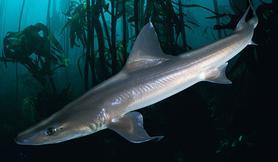
If you have ever taken a boat into the Atlantic Ocean off the coast of New Jersey and tried to fish for anything close to shore, there is a halfway decent chance that you may have caught one of these little guys. Despite their size, the smooth dogfish is just as much a shark as it's larger cousins. The smooth dogfish can grow to be roughly 5 feet in length, but the average is smaller than that. Weight wise this shark can get to be roughly 27 pounds. They make their home along the East Coast of the United States including the Gulf of Mexico and Atlantic Ocean. They can also be found along the Southern coast of Brazil and northern Argentina. Interestingly enough, the individual populations of smooth dogfish seem to keep to themselves despite migrating every year.
For the most part, these sharks are found in shallow waters, normally 60 feet or less. On occasion though they can be found in much deeper waters. On very rare occasions these sharks have been found in mostly fresh water areas, but it is thought that they cannot survive for long in those waters. The smooth dogfish is commonly confused with it's cousin, the spiny dogfish. One of the biggest differences between the two sharks, and easily the easiest way to tell the difference is that the smooth dogfish does not have the dorsal spines that the spiny dogfish has. The gestation period of this shark is roughly 11 months. The mother shark will give birth to between 4 and 20 pups. At birth, the pups are roughly 13 inches in length.
The primary diet of this shark consists of small fish as well as shellfish. The teeth of this shark is by no means adequate for tearing flesh as they are pretty flat and pavement like. This shape makes them perfect for crushing the shells of clams, crabs, etc. As a result of these teeth being the way they are, these sharks pose zero threat to man. The primary predators of these sharks are larger sharks. Hammerheads and Blacktip sharks will frequently choose dogfish as their meal.
While the dogfish is harmless towards people, people can and are having major impacts on this shark. Many fishermen consider this shark as bycatch and a problem fish. Many will simply kill this shark just because it wound up on the hook, stealing their bait. Countless other dogfish are scooped up by commercial fishing vessels and are crushed by the weight of the other fish in the nets or die from the trauma suffered while being caught. Shark finning is also affecting this shark's populations as the fins are used in shark fin soup in Asia. This shark's body is often shipped overseas cheaply as meat for Fish N' Chips as a replacement for other fish. The current population trend of this shark is currently unknown and probably varies from location to location. The most commercial fishing pressure on these sharks can be found off the northeast coast of the United States. With all the pressures these sharks are facing they are currently listed as NEAR THREATENED on the IUCN's Red List.
If you are ever out on a boat in the Atlantic Ocean and you happen to catch one of these guys or gals, take a good look at them. Keep in mind this animal is just as much a shark as any other species of shark in the Ocean. They have a job to do and they do it well. Just because this shark may have stolen your bait is not an excuse to kill it. Respect the shark and know that life can be tough for this smaller species that is dealing with a lot of pressure both inside and outside of the seas.